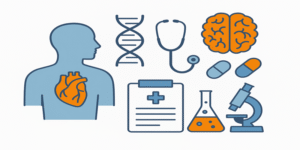The way we present ourselves and our ideas plays a crucial role in effective communication. Strong presentation skills enable us to convey information clearly and persuasively, while personal presentation ensures we create a positive and lasting impression. In professional, academic, and social contexts, these attributes are essential for building trust, demonstrating credibility, and influencing audiences. This article explores the key elements of presentation skills and personal presentation, supported by insights from textbooks, journal articles, and reputable sources.
1.0 Presentation Skills
1.1 Public Speaking
Public speaking is widely regarded as one of the most vital skills for professional success. It involves the ability to communicate with clarity, confidence, and engagement before an audience (Lucas & Stob, 2004). Effective speakers structure their arguments logically, use appropriate language, and maintain eye contact with their audience. For example, in a business setting, a manager presenting a project proposal must use persuasive language, supportive evidence, and vocal authority to secure stakeholder approval.
Research highlights that audiences often judge a speaker within the first few moments of their presentation, making initial delivery critical (Chung et al., 2023). Good posture, confident tone, and clear articulation immediately establish authority, while hesitation or nervousness can undermine credibility.
1.2 First Impressions
First impressions are particularly influential in presentations, as they shape how the audience perceives both the speaker and the message (DePaulo, 1992). According to interpersonal communication research, individuals form initial impressions based on appearance, tone, and body language, often within the first 30 seconds (Hartley, 2010). For example, a well-prepared lecturer who begins with an engaging story can capture attention and set a positive tone for the session. Conversely, a disorganised start may lose audience interest quickly.
1.3 Voice Techniques
The voice is a powerful tool in presentations, as it conveys emotion, emphasis, and clarity. Effective use of clarity, pitch, and tone helps maintain audience engagement and ensures comprehension (Kilag et al., 2023). The classic rule of the “5 Ps”—Preparation, Planning, Prevents Poor Performance—underscores the importance of rehearsal to master voice modulation (Hargie, Dickson & Tourish, 2004).
For instance, politicians often use deliberate pauses, vocal variety, and controlled pitch to persuade and inspire. In contrast, a monotonous delivery risks disengaging listeners. Breathing techniques and posture also contribute to stronger projection and vocal endurance (O’Hair, Stewart & Rubenstein, 2011).
2.0 Personal Presentation
2.1 Personal Hygiene
Personal hygiene is an often-overlooked aspect of professional presence, yet it strongly influences perceptions of professionalism. As Kaye (2002) argues, grooming and cleanliness demonstrate respect for the audience and context. In customer service or healthcare, where face-to-face interaction is constant, maintaining high standards of hygiene directly affects trust and rapport.
2.1.1 Dress Code
The dress code is another crucial element of personal presentation. Appropriate attire signals credibility, authority, and awareness of professional norms (Volin, 2004). For example, a solicitor appearing in court in formal attire conveys seriousness and respect for the legal process, whereas casual dress could be perceived as unprofessional.
Dress codes, however, vary across industries. In creative fields, smart-casual attire may reflect innovation, while in finance or law, formal suits remain standard (Wilson, 2016). Therefore, understanding the expectations of one’s professional environment is key to personal presentation.
2.1.2 Body Language
Body language communicates meaning beyond words. Non-verbal cues—such as gestures, posture, and facial expressions—reinforce spoken messages and influence audience perception (Pease & Pease, 2008). For instance, open gestures and a relaxed stance can communicate confidence, while crossed arms may signal defensiveness or discomfort.
Research suggests that up to 93% of communication may be non-verbal, combining tone of voice, facial expression, and body language (Tuhovsky, 2015). In presentations, maintaining eye contact and nodding affirmatively can build rapport with the audience, while fidgeting or avoiding gaze can diminish impact.
3.0 The Importance of Planning
The foundation of effective presentations lies in planning. The principle of the **5 Ps—Preparation, Planning, Prevents Poor Performance—**reminds speakers that careful organisation is essential for success (Hargie, Dickson & Tourish, 2004). Planning involves clarifying the purpose, understanding the audience, and structuring content into a coherent flow.
For example, a medical educator designing a lecture must consider the learning objectives, the level of knowledge of students, and the best use of visual aids (Bin Abdulrahman & Darami, 2025). This ensures that delivery is not only informative but also engaging and accessible.
4.0 Projecting and Amplifying the Voice
To address large audiences, speakers must project and amplify their voices. This requires attention to clarity, pitch, and tone (Lucas & Stob, 2004). Variation in vocal delivery helps sustain interest and highlights key points. For instance, during a university lecture, a professor may lower their voice for emphasis or raise it to energise the audience.
Good posture and controlled breathing also enhance vocal power. As Stewart and colleagues (2011) argue, diaphragmatic breathing supports sustained speech and reduces vocal strain. This is particularly important for teachers, broadcasters, and performers, whose professions demand frequent public speaking.
5.0 Using Prompt Cards Effectively
Prompt cards are a practical tool to maintain structure during presentations. They allow speakers to note key points in order without reading verbatim (Lucas & Stob, 2004). This technique ensures delivery remains natural, enabling speakers to interact with the audience rather than being tied to a script.
For example, in student presentations, prompt cards often reduce anxiety by providing reassurance. However, over-reliance can lead to disengagement if the presenter spends too much time reading instead of speaking directly to the audience (Eggert, 2012).
6.0 Presentation Day – Being Prepared
On the day of a presentation, preparation is paramount. Recommendations include bringing:
- A digital copy of slides on a USB drive.
- A printed copy of slides for reference.
- A script or prompt cards.
- Readiness to be recorded on video (Kaye, 2002).
Such preparation demonstrates professionalism and ensures that unexpected technical difficulties do not compromise delivery. For example, having a printed copy of slides can save a conference presentation if a laptop fails.
Presentation skills and personal presentation are indispensable for effective communication. Public speaking, first impressions, and voice techniques shape how messages are received, while personal hygiene, dress code, and body language influence credibility and impact. Careful planning, strong vocal projection, and practical tools such as prompt cards further enhance delivery.
Ultimately, presenting effectively requires a combination of verbal clarity, non-verbal confidence, and professional appearance. Mastering these skills not only improves communication outcomes but also strengthens one’s professional reputation.
References
Bin Abdulrahman, K.A. & Darami, H. (2025) Effective Presentation and Communication Skills in Health Profession Education. Springer.
Chung, W.T., Chung, K.C. & Kettaneh, C.A. (2023) ‘First Impressions: Setting the Stage for Better Relationships’, Plastic and Reconstructive Surgery, 152(4), pp. 1–6.
DePaulo, B.M. (1992) ‘Nonverbal behavior and self-presentation’, Psychological Bulletin, 111(2), pp. 203–243.
Eggert, M.A. (2012) Body Language for Business. London: McGraw-Hill.
Hargie, O., Dickson, D. & Tourish, D. (2004) Communication Skills for Effective Management. London: Palgrave Macmillan.
Hartley, P. (2010) Interpersonal Communication. 2nd edn. London: Routledge.
Kaye, E. (2002) Maximise Your Presentation Skills: How to Speak, Look, and Act on Your Way to the Top. London: Thorsons.
Kilag, O.K.T., Quimada, G.M. & Contado, M.B. (2023) ‘The use of body language in public speaking’, Science and Education Journal, 11(3), pp. 45–56.
Lucas, S. & Stob, P. (2004) The Art of Public Speaking. New York: McGraw-Hill.
O’Hair, D., Stewart, R. & Rubenstein, H. (2011) A Speaker’s Guidebook: Text and Reference. Boston: Bedford/St. Martin’s.
Pease, A. & Pease, B. (2008) The Definitive Book of Body Language. London: Orion.
Stewart, R., O’Hair, D. & Rubenstein, H. (2011) A Speaker’s Guidebook: Text and Reference. Boston: Bedford/St. Martin’s.
Tuhovsky, I. (2015) Communication Skills Training. London: Createspace.
Volin, K.J. (2004) Buff and Polish: A Practical Guide to Enhance Your Professional Image and Communication Style. New York: McGraw-Hill.
Wilson, G. (2016) Body Language: The Signals You Don’t Know You’re Sending, and How to Master Them. London: HarperCollins.









